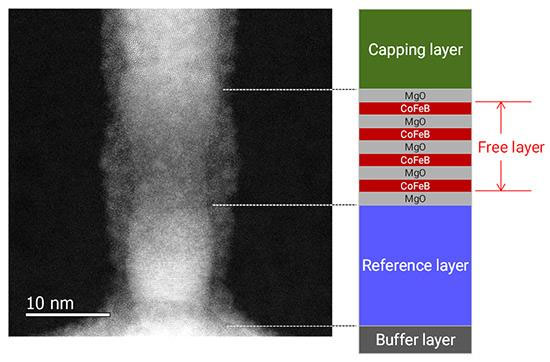Tunnel Junction: Quantum Tunneling for Nanoelectronics and Spintronics
What is a Tunnel Junction?
A tunnel junction is a nanoscale device that consists of two conductive electrodes separated by a thin insulating barrier. The barrier is thin enough to allow electrons to quantum mechanically tunnel through it, enabling current to flow between the electrodes. Tunnel junctions are fundamental building blocks in nanoelectronics and spintronics, where they are used for various applications such as magnetic sensing, data storage, and quantum computing.

Quantum Tunneling in Tunnel Junctions
The key phenomenon that enables the operation of tunnel junctions is quantum tunneling. In classical physics, an electron with insufficient energy cannot overcome a potential barrier. However, in quantum mechanics, there is a finite probability for an electron to tunnel through the barrier, even if its energy is lower than the barrier height. This probability depends on the barrier thickness, height, and the electron's energy.
In a tunnel junction, the insulating barrier acts as the potential barrier, and the conductive electrodes provide the electrons. When a voltage is applied across the junction, electrons can tunnel from one electrode to the other, resulting in a tunneling current. The tunneling current depends on the applied voltage, the barrier properties, and the density of states in the electrodes.
Types of Tunnel Junctions
There are several types of tunnel junctions, each with specific properties and applications:
Metal-Insulator-Metal (MIM) Junctions
MIM junctions consist of two metal electrodes separated by a thin insulating layer, such as aluminum oxide (Al2O3) or magnesium oxide (MgO). These junctions are used in various applications, such as rectifiers, energy harvesters, and single-electron transistors. MIM junctions can also serve as model systems for studying quantum tunneling and electron transport at the nanoscale.
Superconductor-Insulator-Superconductor (SIS) Junctions
SIS junctions have superconducting electrodes separated by a thin insulating barrier. The superconducting properties of the electrodes lead to unique tunneling characteristics, such as the Josephson effect, where a supercurrent can flow through the junction without any applied voltage. SIS junctions are used in superconducting quantum interference devices (SQUIDs), which are highly sensitive magnetic field sensors, and in superconducting qubits for quantum computing.
Magnetic Tunnel Junctions (MTJs)
Magnetic Tunnel Junctions are a type of tunnel junction where the electrodes are ferromagnetic materials, such as iron, cobalt, or their alloys. The tunneling current in an MTJ depends on the relative magnetization orientations of the electrodes, a phenomenon known as tunnel magnetoresistance (TMR). MTJs are the core elements of magnetic random-access memory (MRAM) and spin-transfer torque MRAM (STT-MRAM), which are non-volatile memory technologies with high speed, endurance, and scalability.
Fabrication of Tunnel Junctions
The fabrication of tunnel junctions requires precise control over the deposition and patterning of ultrathin layers at the nanoscale. Some common techniques used in the fabrication of tunnel junctions include:
- Molecular Beam Epitaxy (MBE): MBE is a technique for growing high-quality, single-crystal thin films with atomic layer precision. It is used to grow the ultrathin insulating barriers and ferromagnetic electrodes in MTJs.
- Atomic Layer Deposition (ALD): ALD is a technique for depositing conformal and uniform thin films with thickness control at the atomic level. It is used to deposit the insulating barriers in MIM and SIS junctions.
- Nanolithography: Nanolithography techniques, such as electron beam lithography and nanoimprint lithography, are used to pattern the tunnel junctions with nanoscale resolution. These techniques enable the fabrication of high-density arrays of tunnel junctions for memory and sensing applications.
Applications of Tunnel Junctions
Tunnel junctions have diverse applications in nanoelectronics, spintronics, and quantum technologies:
Magnetic Sensors
MTJs are used as highly sensitive magnetic field sensors in various applications, such as magnetic recording heads, biosensors, and navigation systems. The TMR effect in MTJs enables the detection of weak magnetic fields with high spatial resolution and low power consumption.
Non-Volatile Memory
MTJs are the core elements of MRAM and STT-MRAM, which are emerging non-volatile memory technologies. These memory devices store information in the magnetization state of the MTJs, offering high speed, endurance, and scalability compared to conventional memory technologies like DRAM and flash.
Quantum Computing
SIS junctions are used in superconducting qubits, which are one of the leading platforms for quantum computing. The Josephson effect in SIS junctions enables the coherent control and manipulation of quantum states, which is essential for performing quantum logic operations. Superconducting quantum processors based on SIS junctions have demonstrated high fidelity and scalability, making them promising candidates for realizing large-scale quantum computers.
Challenges and Future Perspectives
Despite the significant progress in tunnel junction technologies, several challenges remain to be addressed. One of the main challenges is the scalability of tunnel junctions to sub-10 nm dimensions, which is necessary for high-density integration in memory and sensing applications. The fabrication of ultrathin, defect-free insulating barriers becomes increasingly difficult at such small scales.
Another challenge is the improvement of the performance and reliability of tunnel junctions. For example, increasing the TMR ratio and reducing the switching current in MTJs are critical for achieving high-density and low-power MRAM. In superconducting qubits, improving the coherence times and reducing the noise in SIS junctions are essential for realizing large-scale quantum processors.
Future research in tunnel junctions will focus on addressing these challenges through the development of advanced materials, fabrication techniques, and device architectures. The exploration of novel tunneling phenomena, such as spin-orbit torque and topological states, will open up new opportunities for tunnel junction-based devices. The integration of tunnel junctions with other emerging technologies, such as neuromorphic computing and quantum sensing, will also drive the development of innovative applications in the future.
Further Reading
Journal of Applied Physics, Tunnel junction I(V) characteristics: Review and a new model for p-n homojunctions
IEEE Journal on Exploratory Solid-State Computational Devices and Circuits, Review of Magnetic Tunnel Junctions for Stochastic Computing
Nature Communications, Ferroelectric tunnel junctions for information storage and processing
